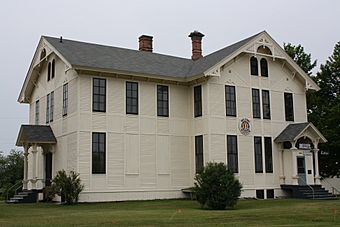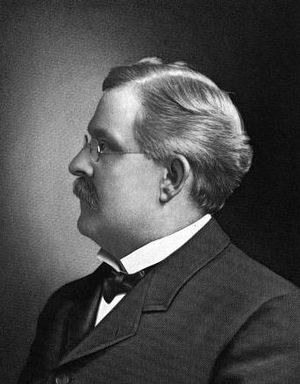IXL Historical Museum facts for kids
|
Wisconsin Land and Lumber Company Office Building
|
|
 |
|
| Location | W5551 River Street North, Hermansville, Michigan |
|---|---|
| Built | 1882 |
| Architectural style | Stick/Eastlake architecture |
| NRHP reference No. | 91000901 |
Quick facts for kids Significant dates |
|
| Added to NRHP | July 26, 1991 |
The IXL Historical Museum is a special place in Hermansville, Michigan. It includes an old office building, a home, and other buildings. The main building was once the main office for a company called Wisconsin Land & Lumber. Later, it became a museum.
The museum started in 1982. The main building, also known as the Wisconsin Land and Lumber Company Office, is very important. It was named a Michigan State Historic Site in 1973. Then, in 1991, it was added to the National Register of Historic Places. This means it's a really important historical spot!
Contents
History of the IXL Museum Building
How the Company Started
The main building was first the office for the Wisconsin Land & Lumber Company. A man named Charles J. L. Meyer, who was from Germany, started this company. He used to make wooden windows, doors, and blinds in Wisconsin.
In 1878, Meyer began buying land in Menominee County, Michigan. He wanted to get pine trees for his factory. By 1881-1882, he moved his company to Hermansville, Michigan. He built the company's main office there. Meyer kept buying land, and his company eventually owned a huge amount of land. It was spread across eight counties.
However, the company grew too fast. In 1890, it faced money problems and sales dropped. Meyer had to sell some of his company's property. Most of the pine trees were already cut down. So, the company started making hardwood flooring instead.
The Wisconsin Land & Lumber Company was special because it was one of the first to use hardwoods. They also created new machines to make flooring. Their flooring was called "IXL," which meant "I excel." This name showed how proud they were of their high-quality product. Every piece of flooring had "IXL" stamped on it inside a circle.
Making hardwood flooring was not easy at first. The company started to struggle. Around the same time, Charles Meyer had a riding accident. He hurt his brain and could no longer run the company. His son-in-law, Dr. George Washington Earle, took over.
George Washington Earle Steps In
George Washington Earle was born in New York in 1849. When he was young, he left home and worked on a farm. He went to school and became a teacher. But he wanted to do more.
In 1868, he saved money to go to medical college. He graduated in 1872 and became a doctor. He built a very successful medical practice. In 1886, he traveled to Europe and met Emma Meyer, Charles Meyer's daughter. They got married in 1888.
In 1889, Earle stopped being a doctor and moved to Michigan with his wife. He put a lot of his own money into his father-in-law's business. He became a vice-president just before the company faced big money problems in 1890. With Charles Meyer unable to work, Earle had to take charge of the company.
Earle's Leadership and Success
Earle worked hard to save the company. He talked to the people the company owed money to. He got new loans and cut down on spending. He even bought some of the company's debt himself. He made big changes to how the business was run.
Earle also promoted the company's IXL maple flooring. This was perfect timing because people started wanting more hardwood floors. The Wisconsin Land & Lumber Company created a special way to make flooring with a tongue and groove design. Because of this, the company became one of the biggest hardwood floor makers in the United States. The IXL logo became so famous that architects would ask for "IXL or similar" flooring in their building plans.
As more people wanted hardwood flooring, the company did very well. They finally paid off all their debts in 1910. When it became too expensive to buy land with trees, Earle started buying logs from smaller logging companies. Earle led the company until he passed away in 1923. His two sons, G. Harold and Stewart Prescott Earle, then took over. The main office in Hermansville stayed the company's headquarters until the last of Meyer's grandsons passed away in 1978.
Buildings at the Museum
The main office building at the IXL Historical Museum is like a time capsule. It has many items from the 1800s. Not much has changed inside since the 1900s or 2000s. The building is made of wood and has two floors. It has a "T" shape.
The outside of the building has special wooden siding. It has decorative wood pieces that go up and down and sideways, matching the windows. There are also diagonal wood pieces on the roof's pointed parts. Small triangle-shaped supports hold up the roof's edges. You can enter through small porches at the front and side. The back of the building is simpler.
Inside the building, you can see old company papers. There are also old crank telephones, big oak desks, dictaphones (machines to record voices), inkwells, and adding machines. The paymaster's office is near an entrance. Workers used to get paid in company scrip, which was like special money they could use at the company store. The second floor of the building was once a home.
The company also built the town and houses for its workers. They sold these houses after World War II. Other buildings that are part of the museum complex today include a company house, a warehouse for farm products, and a train depot that has been fixed up.
Images for kids
-
Wilson's train depot, later used at Powers









